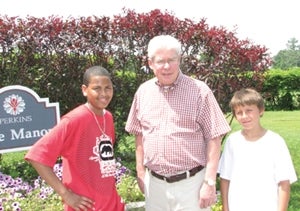When Dr. Charles P. Conroy first went to work there 20 years ago, the Doctor Franklin Perkins School in Lancaster was an intimidating presence to many in the community. Housed in a 19th-century mansion, the school was a residence for children with mental illnesses and behavioral problems.
Today, one of the most visible features of the school is a brightly colored playground where local families – families whose children have none of the troubles that Perkins was founded to address – come to play.
Inviting the local community in has been key to Perkins’ survival, and offers lessons for all nonprofits trying to stay relevant and stable.
These days, instead of a monolithic approach to a particular group of children, Perkins provides all kinds of treatment, both on-site and off, for children and adults with a variety of mental and emotional problems, and even for some “typically developing” kids with no such difficulties at all.
“I’ve never been a believer in having all your eggs in one basket,” Conroy said.
He says this approach has helped fuel significant growth at Perkins.
In the past 20 years, the school’s operating budget has gone from $2.3 million to $20 million, and its staff has increased from 140 to more than 300.
Bill Stock, vice president for government and community relations at Seven Hills Foundation in Worcester, said the push to diversify is common for human service organizations. In its 55-year history, he said, Seven Hills itself has gone from an organization dealing mostly with people with developmental disabilities to one with a much wider focus.
Today, the foundation tackles everything from AIDS prevention and anti-smoking programs to advocacy for disabled clients who need housing assistance.
Stock said one force driving human service groups’ changing focuses is state agencies’ emphasis on helping individuals get support in their own communities whenever possible.
“If that’s the funding source,” he said, “You’ve got to be able to adapt. We kind of look at it as an opportunity.”
Conroy agreed that external pressures have changed Perkins’ focus. For reasons both pedagogical and economic, the state agencies and local school districts that send students to the school now look much less favorably on residential care than they once did.
For years, Conroy said, schools have been trying to avoid placing students in a setting that can come with a $175,000 annual price tag.
And over the last two or three years, the state Department of Social Services has adopted similar policies, becoming more reluctant to place the abused and troubled children they work with in far-flung residential settings.
New Pots of Money
Besides, Conroy said, offering more diverse services means getting funding from more diverse sources, which insulates the school against any big cuts at specific state agencies.
Conroy said people in the for-profit business world are sometimes surprised at the thought he puts into the financial side of running the school.
“I think people in the non-human services tend to look at us as we’re nice people who do good work, but we’re probably not very good at running a business,” he said.
In fact, the school takes long-term planning very seriously. In a strategic plan it put together last year, Perkins laid out ways to improve quality and expand its scope of operations between 2007 and 2008. Many of the programs proposed there are already beginning.
The most ambitious program the school has rolled out is a new child care center, housed in a new, $1.1 million building.
Children with developmental problems or illnesses are welcome at the center, but most of the 30 babies, toddlers and preschoolers now enrolled there are typically developing kids.
Other programs now underway include free classes for local parents, outreach to local school districts to help them provide in-house support for students with relatively mild behavioral problems and a summer camp for middle-school students from Fitchburg.
While it increases its involvement with the local community, Perkins is also striving for more widespread recognition (something that Conroy says isn’t made any easier by the common confusion with the Perkins School for the Blind in Watertown).
It is marketing a residential program for children with Asperger Syndrome all over New England, and it recently started Perkins Magazine, a PR vehicle that it is distributing nationally.

